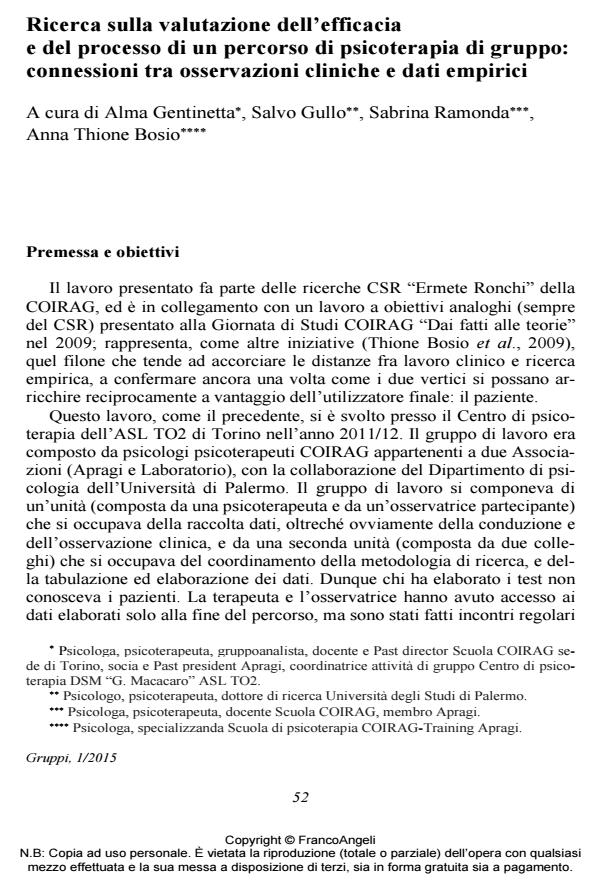Effectiveness Research about Psychotherapy Group: comparison between Clinical Observation and Empirical Data
Journal title GRUPPI
Author/s Alma Gentinetta, Salvo Gullo, Sabrina Ramonda, Bosio Anna Thione
Publishing Year 2015 Issue 2015/1 Language Italian
Pages 22 P. 52-73 File size 83 KB
DOI 10.3280/GRU2015-001005
DOI is like a bar code for intellectual property: to have more infomation
click here
Below, you can see the article first page
If you want to buy this article in PDF format, you can do it, following the instructions to buy download credits

FrancoAngeli is member of Publishers International Linking Association, Inc (PILA), a not-for-profit association which run the CrossRef service enabling links to and from online scholarly content.
This article is an example showing the useful relationship between clinical practice and scientific research. The aim of our study is the evaluation (effectiveness, process) in a small psychotherapy group, groupanalitic methodology, the group ended in one year and done in a public Psychotherapy Center. The patients of the group have various diagnosis (neurosis, personality disease). The empirical data collected before, during and at the end of the group were processed and crossed from the colleagues’ group of the research only at the end of the therapeutic process: so the comparison between clinical observation and data could be done in a quite indipendent way. From the results it springs either common conclusions or different between clinical observations and empirical data; otherwise new interesting questions come out: you can see our remarks about it.
Keywords: Psychotherapy group, groupanalitic methodology, clinical practice, empirical research, effectiveness, process, evaluation
- Chiappelli M., Lo Coco G., Gullo S., Bensi L., Prestano C. (2008). L’Outcome Questionnaire 45.2. Adattamento italiano di uno strumento per la valutazione dei trattamenti psicologici. [The Outcome Questionnaire 45.2. Italian Validation of an Instrument for the Assessment of Psychological Treatments]. Epidemiologia e Psichiatria Sociale, 17, 2: 152-161.
- Elliott R. (2000). Hermeneutic Single Case Efficacy Design. Paper presented at 31st Annual Meeting of Society for Psychotherapy Research, Chicago. (Trad. it. in: Di Nuovo S. (ed.). Strumenti qualitativi per la ricerca sulla psicoterapia: intervista sul cambiamento psicoterapeutico di R. Elliott. Ricerca in Psicoterapia, 3, 2-3: 135-146.
- Gaston L., & Marmar C.R. (1993). “Manual of the California Psychotherapy Alliance Scales (CALPAS)”. Unpublished manuscript. Montreal (Canada): McGill University.
- Horowitz L.M., Alden L.E., Wiggins J.S. & Pincus A.L. (2000). Inventory of Interpersonal Problems (IIP-32/IIP-64). London: Psychological Corporation.
- Lambert M.J., Morton J.J., Hatfield D.R., Harmon C., Hamilton S., Shimokawa K., Christopherson C. & Burlingame G.B. (2004). Administration and Scoring Manual for the Outcome Questionnaire (OQ-45.2) (3rd ed.). Wilmington, DE: American Professional Credentialling Services, LLC. Millon T. (1997). MCMI-III, Millon Clinical Multiaxial Inventory-III Manual. Minneapolis: National Computer Systems.
- Thione Bosio A., Prestano C., Gullo S., Tagliarini V., Minetti S., Serra M. (2009). Valutazione dell’efficacia di un percorso psicoterapeutico di gruppo. Dimensione del cambiamento. Quaderno CSR COIRAG, 12.
Alma Gentinetta, Salvo Gullo, Sabrina Ramonda, Bosio Anna Thione, Ricerca sulla valutazione dell’efficacia e del processo di un percorso di psicoterapia di gruppo: connessioni tra osservazioni cliniche e dati empirici in "GRUPPI" 1/2015, pp 52-73, DOI: 10.3280/GRU2015-001005